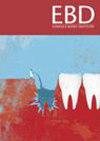What about anterior endocrowns?
Q3 Dentistry
引用次数: 0
Abstract
Fehrenbach J, de Soares J L S, do Nascimento Foly J C S, Miotti L L, Münchow E A Mechanical performance of endocrown restorations in anterior teeth: A systematic review and network meta-analysis. Dent Mater 2025; https://doi.org/10.1016/j.dental.2024.10.012 . A systematic review and network meta-analysis (NMA) of anterior endocrown mechanical performance compared to conventional crowns on endodontically treated teeth (ETT). An online search of major databases was conducted and relevant studies were selected. Data was extracted and meta-analyses performed comparing mechanical outcomes of anterior endocrowns to other crown systems. Endocrowns on the anterior dentition can be considered if mechanical fracture is a concern, however more research needs to be done before definitive case selection. Two independent reviewers searched six electronic databases (PubMed, Scopus, Web of Science, Embase, SciELO and LILACS) using compounded terms like ETT and anterior and endocrown along with their variates. Manual searches were also done from the reference list of chosen studies. Following the search titles were put through Rayyan, an AI-powered systematic reviewer to remove duplicates. The reviewers then screened 25 random titles and abstracts independently and repeated this with a third reviewer. Inclusion criteria were studies examining anterior ETT and endocrown compared with a different restoration. Exclusion criteria were non-experimental studies, theses, languages other than English Spanish or Portuguese and studies not evaluating mechanical performance. From this 24 studies were read in full and 11 were selected for the review. Bias risk assessment was done by two reviewers using the RoBDEMAT tool for in vitro studies and ROBFEAD tool for Finite Element Analysis (FEA) studies. The studies are scored as low, med, or high risk according to each tool’s domains. Two reviewers extracted the data onto Microsoft Excel including authors name and year of publication, tooth type, endocrown depth, distance between the CEJ and finishing line,surface treatment, luting agent, thermocycling method, etc. Data synthesis and analysis was performed by MetaInsight V4 4.0.0 and two independent NMA’s were made. The first NMA used load-to-fracture data and a mean difference outcome while the second used irreparable fracture data and a risk ratio outcome. Both used a 95% credible interval(Crl). Comparisons were evaluated using Surface Under the Cumulative ranking Curve (SUCRA), where a value closer to 100% indicates greater resistance to fracture. Eight studies used in vitro experiments, most of them investigating load-to-fracture and failure mode of fractured restorations and one study the pull-out bond strength. The remaining three studies used FEA models and examined von mises criterion by quantifying a material’s fracture under stress. The first NMA considered load-to-fracture data and examined five studies. The probabilistic analysis showed teeth restored with a Glass Fibre Post (GFP) and composite crown performed best (SUCRA = 95.23%), with higher load-to-fracture values (MD 165.0, 95% CRL 28.3, 301.0) than the Composite endocrown group (MD 78.1 95% Crl 6.21, 150.0). Lowest ranking was the GFP plus ceramic crown group, with ceramic endocrowns and ceramic crowns without post in between. The second NMA analysed irreparable fracture data from five studies. The composite endocrown group showed a lower catastrophic fracture risk (RR 0.413, 95% Crl 0.152, 0.859) compared to the GFP ceramic crown group (RR 1.36, 95% Crl 1.09, 1.80). Probabilistic analysis shows composite endocrowns with the lowest risk of irreparable fracture (SUCRA = 96.84%), followed by ceramic crown with no core, ceramic endocrowns and GFP crown groups with the highest risk. Endocrowns may be a viable choice for endodontically treated anterior teeth because they perform similarly to other restorative systems under mechanical load in lab and model scenarios. GRADE rating is low due to high risk of bias.那么前牙髓呢?
Fehrenbach, de Soares, J L S, do Nascimento Foly, J C S, Miotti, L L, m nchow E, A .前牙内冠修复体力学性能的系统评价和网络meta分析。Dent Mater 2025;https://doi.org/10.1016/j.dental.2024.10.012 .目的和方法:系统回顾和网络荟萃分析(NMA)对根管治疗牙齿(ETT)前牙冠与传统牙冠力学性能的比较。在线检索各大数据库,选取相关研究。提取数据并进行荟萃分析,比较前牙髓与其他牙冠系统的力学结果。如果担心机械骨折,可以考虑在前牙列上使用牙髓冠,但是在确定病例选择之前需要做更多的研究。数据来源:两名独立审稿人检索了六个电子数据库(PubMed, Scopus, Web of Science, Embase, SciELO和LILACS),使用ETT和anterior and endocrown等复合术语及其变量。还从所选研究的参考列表中进行了人工搜索。搜索后的标题将通过人工智能系统审稿人Rayyan来删除重复内容。然后,审稿人独立筛选了25个随机标题和摘要,并与第三位审稿人重复了这一过程。研究选择:纳入标准是检查前路ETT和内冠与不同修复体的比较。排除标准是非实验研究、论文、英语、西班牙语或葡萄牙语以外的语言以及不评估机械性能的研究。从这24项研究中,有11项被选为综述。偏倚风险评估由两位评论者使用体外研究的RoBDEMAT工具和有限元分析(FEA)研究的ROBFEAD工具完成。根据每个工具的领域,这些研究被分为低风险、中等风险或高风险。数据提取与综合:两位审稿人将数据提取到Microsoft Excel中,包括作者姓名、发表年份、牙型、内冠深度、CEJ与终点线的距离、表面处理、luting剂、热循环方法等。采用MetaInsight V4 4.0.0软件对数据进行综合分析,并进行两次独立的NMA。第一个NMA使用载荷-骨折数据和平均差异结果,而第二个NMA使用不可修复骨折数据和风险比结果。两者均使用95%可信区间(Crl)。使用累积等级曲线下的表面(SUCRA)进行比较,其中接近100%的值表示更强的抗破裂能力。结果:8项研究采用了体外实验,其中大部分研究的是断裂修复体的载荷-断裂和破坏模式,1项研究的是拔出键合强度。其余三项研究使用了有限元模型,并通过量化材料在应力下的断裂来检验冯米塞斯准则。第一个NMA考虑了载荷-断裂数据,并检查了五项研究。概率分析显示,玻璃纤维桩(GFP) +复合冠修复牙体的修复效果最佳(SUCRA = 95.23%),其载荷-断裂值(MD 165.0, 95% CRL 28.3, 301.0)高于复合内冠组(MD 78.1, 95% CRL 6.21, 150.0)。排名最低的是GFP +陶瓷冠组,中间有陶瓷内冠和不带桩的陶瓷冠。第二个NMA分析了来自五项研究的不可修复骨折数据。复合内冠组发生灾难性骨折的风险较GFP瓷冠组低(RR = 0.413, 95% Crl = 0.152, 0.859) (RR = 1.36, 95% Crl = 1.09, 1.80)。概率分析显示,复合牙冠发生不可修复性骨折的风险最低(SUCRA = 96.84%),其次为无核陶瓷牙冠组、陶瓷牙冠组和GFP牙冠组。结论:在实验室和模型试验中,牙髓修复体在机械负荷下的表现与其他修复体相似,因此牙髓修复体可能是治疗前牙的可行选择。GRADE评分低,因为偏倚风险高。
本文章由计算机程序翻译,如有差异,请以英文原文为准。
求助全文
约1分钟内获得全文
求助全文
来源期刊

Evidence-based dentistry
Dentistry-Dentistry (all)
CiteScore
2.50
自引率
0.00%
发文量
77
期刊介绍:
Evidence-Based Dentistry delivers the best available evidence on the latest developments in oral health. We evaluate the evidence and provide guidance concerning the value of the author''s conclusions. We keep dentistry up to date with new approaches, exploring a wide range of the latest developments through an accessible expert commentary. Original papers and relevant publications are condensed into digestible summaries, drawing attention to the current methods and findings. We are a central resource for the most cutting edge and relevant issues concerning the evidence-based approach in dentistry today. Evidence-Based Dentistry is published by Springer Nature on behalf of the British Dental Association.
 求助内容:
求助内容: 应助结果提醒方式:
应助结果提醒方式:


